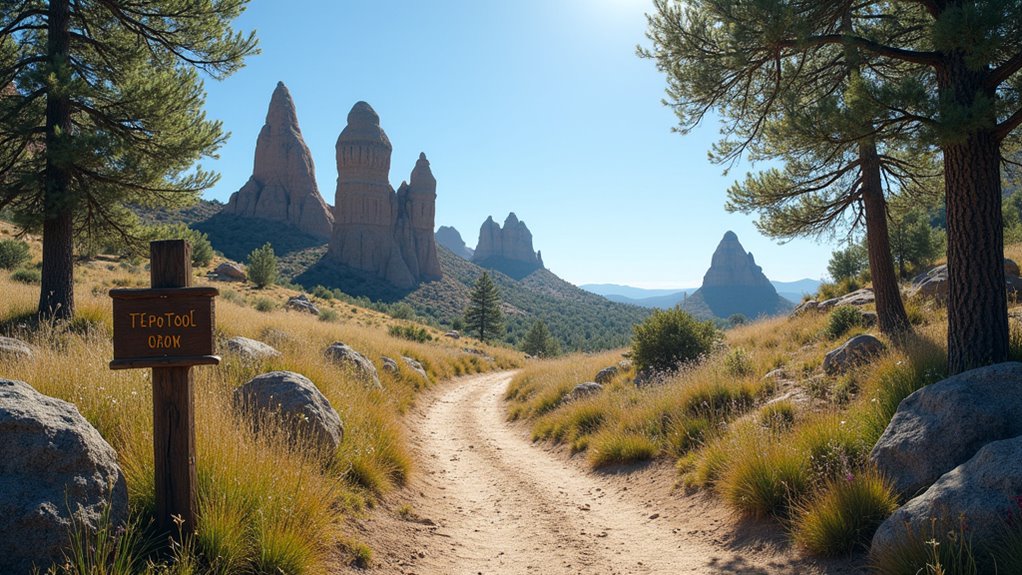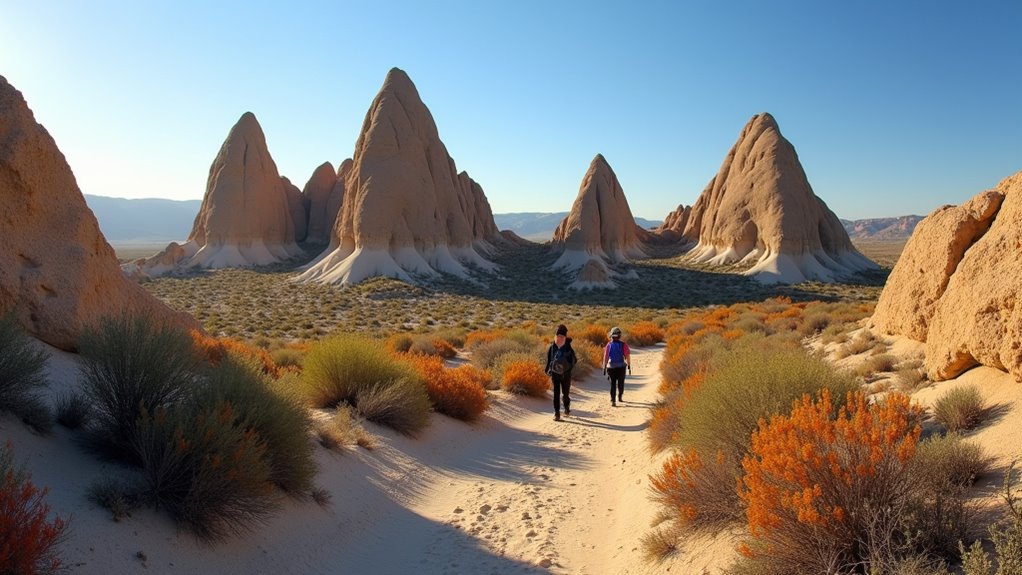When Will Tent Rocks Reopen
This post contains affiliate links. As an Amazon Associate, we earn from qualifying purchases.
Tent Rocks National Monument reopened on November 21, 2024, and will be open for visitors from February 1 to December 14, 2025. It will be closed for the holidays from December 15, 2024, through January 31, 2025. To visit, you must obtain both a BLM Ticket Reservation and a Cochiti Pueblo Tribal Access Pass, with reservations available Thursday through Monday. Tickets often sell out weeks in advance, so it’s best to plan early. Additional details about visiting options and requirements are provided later in this article.
Essential Facts in 30 Seconds
- Tent Rocks National Monument reopened on November 21, 2024.
- Open to visitors from February 1 to December 14, 2025.
- Closed for holidays from December 15, 2024, to January 31, 2025.
- Short closures during Easter and Thanksgiving holidays.
- Annual visitor limit set at 75,000 to protect the monument.
Reopening Date and Schedule
Tent Rocks National Monument opened again on November 21, 2024. Visitors can explore the site from February 1 to December 14, 2025. The monument closes for the holidays from December 15, 2024, to January 31, 2025.
There are also short closures during Easter and Thanksgiving.
Only 75,000 people can visit each year. This helps protect the natural beauty. Visitors must check in at the Cochiti Visitor Center starting at 7:45 a.m. Pilot vehicles take visitors into Tent Rocks beginning at 8:00 a.m.
Everyone must leave by 4:00 p.m.
Plan your trip early. Follow the schedule to enjoy Tent Rocks safely. This keeps the area clean and beautiful for all.
Admission and Permit System

Visiting Tent Rocks National Monument requires a special admission and permit system. This system helps protect the beautiful scenery and gives you a better visit.
First, complete a two-step reservation process. Book your BLM Ticket Reservation at recreation.gov. Tickets are available Thursday through Monday, from February 1 to December 14, 2025.
After this, buy the Cochiti Pueblo Tribal Access Pass online at purplepass.com. The BLM fee costs $5 for each adult over 16 years old. The Tribal Access Pass costs $20 for adults and $10 for children aged 2 to 16.
Both fees must be paid to enter. Children under 16 enter free with the BLM ticket but still need the Tribal Access Pass. Bring both permits with you. Without them, you can’t enter the monument.
Follow these rules to enjoy your trip safely and legally.
Visitor Experience and Management

Tent Rocks shows careful efforts to stop erosion and keep trails safe.
A new permit system limits visitor numbers. This helps keep trails peaceful and enjoyable. Following these rules protects the land for everyone.
Your visit helps keep this place beautiful and special.
Erosion Recovery Efforts
Many visitors wait eagerly for Tent Rocks to reopen. Protecting this special place needs careful work. Erosion wears away the soft pumice and tuff rocks. This can damage the hoodoos, making them disappear.
Scientists studied the area for five years after a 2011 wildfire. They looked at water flow and how to keep soil strong. The Bureau of Land Management (BLM) watches the site closely. They change their plans based on what they find. This keeps visitors safe and the rocks safe too.
Before opening, workers check trails and viewpoints for erosion risks. Programs teach visitors how to help keep Tent Rocks beautiful. Everyone’s care helps protect this amazing place.
Visitor Management Strategies
Tent Rocks National Monument uses smart visitor management to protect its beauty and improve your visit.
Visitors must reserve their spot through Recreation.gov. This limits visitors to about 50,000 each year, down from over 110,000 before the pandemic. Reservations are needed Thursday through Monday. This helps keep visitor numbers steady and reduces crowding.
Traffic moves smoothly from the Cochiti Visitor Center to the park. Entry times are staggered to prevent long waiting lines, which once lasted over an hour.
Clear signs and educational programs help you learn about the park’s nature and history. These steps protect the land and make your visit safe and enjoyable.
Geological and Cultural Significance
Tent Rocks shows strange, tall rock shapes called hoodoos.
Volcanoes formed these shapes millions of years ago. Wind and rain slowly wore the rocks into their current forms.
The Cochiti Pueblo people see these rocks as very special and sacred. Knowing about the rocks and their meaning helps you enjoy and respect the place more.
This land tells stories of nature and culture combined.
Unique Hoodoo Formations
Hoodoo formations at Kasha-Katuwe captivate with their strange shapes and colors. These tall, thin rock columns reach from 3 to 90 feet high. They form from volcanic ash, pumice, and tuff layers. Wind and water slowly wear away the soft rock. Harder rocks on top, called caprocks, protect the pillars below. Without caprocks, hoodoos would crumble quickly.
The erosion process changes the landscape every year. Trails here offer views of these unique shapes. Walking among the hoodoos feels like stepping into a natural sculpture garden.
Visitors enjoy both easy and challenging hikes. The mix of colors and shapes makes this place special. Nature’s work of art, shaped over centuries.
Sacred Pueblo Heritage
The Kasha-Katuwe Tent Rocks National Monument holds deep meaning for the Pueblo de Cochiti people. This land is sacred and connects them to their traditions and ancestors. Pueblo members perform special ceremonies here each season. These events strengthen their spiritual bond with the land.
Unique rock formations represent ideas of creation and life’s continuity. These symbols carry strong religious value. Respecting these features is key to their rituals. The monument’s protected status helps keep cultural practices alive. It also preserves the land’s natural beauty.
Visitors support the Pueblo community by honoring this sacred place. This respect helps keep their heritage strong for future generations.
Reservation Availability and Policies
A smooth visit to Kasha-Katuwe Tent Rocks National Monument starts with understanding the rules.
You must get a BLM Ticket Reservation through Recreation.gov to enter. Tickets can’t be shared or sold to others. A Cochiti Pueblo Tribal Access Pass is also required. Buy it separately on Purplepass.com.
Reservations run from Thursday to Monday, February 1 to December 14, 2025. Tickets sell out fast, often 3 to 4 weeks early during busy times. No refunds are given if you miss your date, except for closures due to weather or emergencies.
Follow these steps to enjoy this special place without any problems.
Official Sources and Visitor Guidance
Check the official sources for the latest visitor rules at Kasha-Katuwe Tent Rocks National Monument. The park stays open Thursday through Monday, from February 1 to December 14, 2025.
Visitors must reserve entry in advance. You need two permits: a BLM Ticket Reservation from recreation.gov and a Cochiti Pueblo Tribal Access Pass from purplepass.com.
The trails can be tough. Visitors have noted some accessibility problems. Plan your visit carefully and be ready for the hike.
Respect the land. Don’t disturb plants, rocks, or cultural items. This site is sacred to the local people.
Call the Rio Puerco Field Office at 505-761-8700 for details. Official New Mexico tourism websites also offer updates.
Checking these sources often helps protect the park and gives you a better visit experience.
Frequently Asked Questions
What Are the Best Times to Visit Tent Rocks?
Spring and fall offer the best weather for visiting Tent Rocks. Temperatures stay cool and comfortable during these seasons. Plan your hike early on weekdays to avoid crowds. Early mornings bring peace and quiet on the trails. Weekends and midday hours tend to be busy and noisy. This way, you enjoy the unique rock formations without many people around.
Are Pets Allowed in Kasha-Katuwe Tent Rocks National Monument?
Pets cannot enter Kasha-Katuwe Tent Rocks National Monument. Park rules do not allow animals on trails or in picnic areas. This helps protect the plants and wildlife. Visitors enjoy clean and safe paths without pets. Leave your pets at home for a better visit. Respect nature and follow the park’s rules. Enjoy hiking with fresh air and quiet surroundings.
Is Camping Permitted Near Tent Rocks?
Camping is not allowed inside Tent Rocks due to park rules. You can camp nearby at places like Cochiti Lake Recreation Area and Santa Fe National Forest. These spots offer good facilities and beautiful nature views. Both areas provide safe and fun camping experiences close to Tent Rocks. Plan ahead and check for campsite availability before you go.
What Should I Bring for My Visit?
Staying hydrated cuts heat exhaustion risk by over 50%. Bring water, sunscreen, and sturdy shoes. Pack snacks to keep energy up. Follow visitor rules for safety and fun. Stay cool, stay safe, and enjoy your visit.
Are There Guided Tours Available at Tent Rocks?
No official guided tours exist at Tent Rocks right now. Some local groups might offer tours. Most visitors explore the trails alone. You can enjoy the strange rock shapes and pretty views at your own speed. It feels like a quiet adventure just for you. This way, you can stop and look whenever something catches your eye.
Conclusion
Tent Rocks will reopen soon, so plan your visit now. Check official websites for the latest dates and rules. You need a permit to enter, so book early to secure your spot. The park is famous for its unique rock formations and beautiful trails. Knowing the visitor rules helps you avoid surprises. Enjoy the stunning views and learn about the area’s history. Stay updated to have a safe and fun trip to Tent Rocks.
